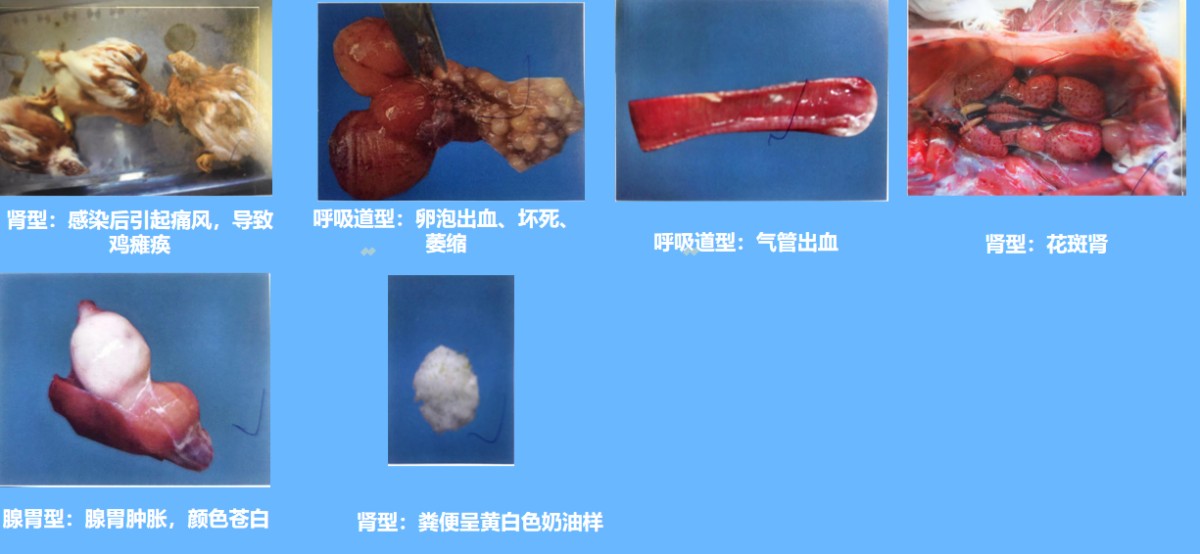(1) Clinical symptoms
The sick chickens have decreased feed intake, closed eyes and are sleepy.
In the early stage, they have respiratory symptoms such as runny nose, tearing, and coughing. In the middle and late stages, they become extremely emaciated and excrete yellow-green or white thin feces. They eventually die of exhaustion.
(1) Clinical symptoms
The disease is divided into respiratory, renal, glandular stomach and reproductive types.
1. Respiratory type
Chickens (less than 5 weeks old): sick chickens are listless, shrink their heads, close their eyes and fall asleep, their wings droop, their feathers are loose and dull, they are afraid of cold and huddle together, they have runny noses, tears, sneeze, stretch their necks and open their mouths to breathe, and make wheezing sounds when breathing. Some chickens have swollen faces.
Laying hens: In addition to respiratory symptoms, laying hens have delayed laying and decreased egg production, with decreased egg production and swollen faces. The number of thin-shelled eggs, discolored eggs, deformed eggs, "pigeon eggs" or rough-shelled eggs increases by 25% to 50%. The egg white is as thin as water and is easy to separate from the yolk. The egg white adheres to the surface of the shell membrane. The hatchability of the eggs is reduced, and it is difficult for the egg production to return to the original level. If 1-day-old chicks are infected with respiratory infectious bronchitis, permanent damage to the oviduct will occur. If 10-18-day-old chicks are infected, more false hens will occur, which is also one of the reasons why laying hens do not lay eggs or have no peak in egg production.
2. Renal type
The onset age is mainly concentrated in chicks aged 2-4 weeks. The mortality rate is high, up to 30% in chicks. It also occurs in growing chickens and laying hens. The mortality rate of adult chickens and laying hens increases when urolithiasis occurs. Sick chickens are depressed, dehydrated, with dry claws, dark combs, faces and skin all over the body, drooping feathers, fear of cold, reduced feed intake, and even loss of appetite. The amount of water consumed increases, and a large amount of white lime-like feces or white cream-like loose feces are discharged, and the feathers around the anus are contaminated by feces. Some chickens are paralyzed by gout and show biphasic clinical symptoms, that is, there are mild respiratory symptoms for 2 to 4 days in the early stage, then the respiratory symptoms disappear, and the chickens appear to be "recovering" on the surface. They enter the acute kidney disease stage in about 1 week, with sporadic deaths, etc.

The treatment of infectious bronchitis requires targeted anti-infection treatment based on the cause (viral or bacterial infection), combined with symptomatic supportive therapy. The specific plan is as follows:
1. Cough and expectoration
Dry cough without sputum: use dextromethorphan or pentoxyverine
Thick and sticky sputum: use ambroxol, acetylcysteine or ambroxol oral solution to dilute the sputum
2. Relieve wheezing
Bronchodilators: salbutamol, terbutaline nebulizer inhalation or oral theophylline drugs
For severe cases: short-term inhalation of glucocorticoids (such as budesonide) to reduce airway inflammation
3. Antipyretic and supportive treatment
Body temperature>38.5°C: take acetaminophen or ibuprofen
Ensure adequate water intake, rest in bed, and avoid fatigue
1. Nebulization inhalation
When the sputum is thick or wheezing is obvious, use budesonide + terbutaline nebulization to promote expectoration and relieve spasms
2. Oxygen therapy
For patients with reduced blood oxygen saturation or dyspnea, oxygen inhalation is required to maintain respiratory function
3. Physical therapy
Patting the back to expectorate, breathing training (such as pursed lip breathing) to improve airway patency
Please give us a message
